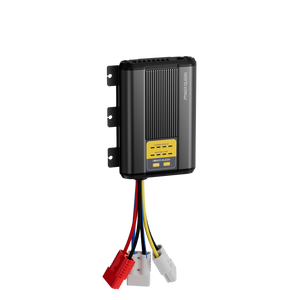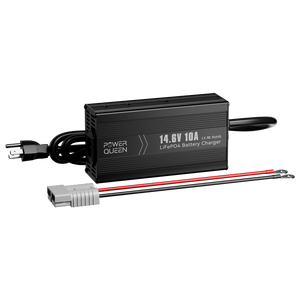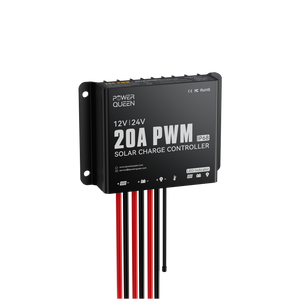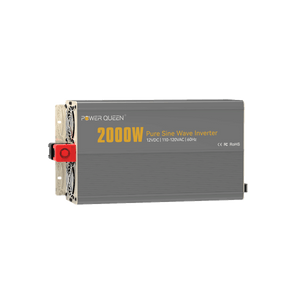The Ultimate Guide to LiFePO4 Lithium Battery Voltage Charts
Table of Content
- Part 1. Understanding LiFePO4 Lithium Battery Voltage
- Part 2. LiFePO4 Voltage Chart
- Part 3. LiFePO4 Battery Charging & Discharging
- Part 4. LiFePO4 Bulk, Float, And Equalize Voltages
- Part 5. How Does Voltage Affect LiFePO4 Battery Performance?
- Part 6. How to Measure Battery Voltage
- Part 7. FAQs for LiFePO4 Voltage Chart
- Part 8. Conclusion
Part 1. Understanding LiFePO4 Lithium Battery Voltage
LiFePO4 (Lithium Iron Phosphate) batteries have gained widespread popularity due to their high energy density, long cycle life, and superior safety features. These batteries are commonly used in a variety of applications, including solar energy storage, electric vehicles, marine equipment, and off-grid power systems. Understanding the unique voltage characteristics of LiFePO4 batteries is essential when working with them. Unlike traditional lead-acid batteries, LiFePO4 batteries have a distinct voltage profile that significantly impacts their charging, discharging, and overall performance. Renowned for their stability, safety, and extended cycle life, LiFePO4 batteries typically have a nominal cell voltage of 3.2 volts.
In comparison, conventional lithium-ion batteries generally have a nominal voltage of 3.6 to 3.7 volts per cell.
The lower voltage range and stable chemistry of LiFePO4 batteries make them especially suitable for applications requiring long-term reliability and safety, such as RV camping, renewable energy systems, marine trolling motors, golf carts, and portable power solutions.

Suggest reading:
- The Ultimate Guide to Lithium Batteries in Cold Weather
- AGM vs Lithium Ion Backup Batteries: Why Some Systems Lose Power at 50%
- What Size Battery for Trolling Motor
- AGM Vs. Lithium Batteries: Which Is Better For RV And Marine
Part 2. LiFePO4 Voltage Chart
The LiFePO4 Voltage Chart is an essential tool for monitoring the charge levels and overall health of Lithium Iron Phosphate batteries. This visual guide illustrates the voltage range from full charge to complete discharge, making it easy for users to evaluate the current charge status of their batteries. It serves as a valuable reference for assessing performance, optimizing usage, and prolonging the lifespan of these durable and efficient energy storage solutions. This chart is a crucial resource for maximizing the effectiveness of Power Queen's LiFePO4-powered products.
|
State of Charge |
|||
|
100% |
≥13.33V |
≥26.66V |
≥53.32V |
|
75% |
13.3~13.33V |
26.6~26.66V |
53.2~53.32V |
|
50% |
13.15~13.2V |
26.3~26.4V |
52.6~52.8V |
|
25% |
13~13.15V |
26~26.3V |
52~52.6V |
|
0% |
10~12V |
20~24V |
40~48V |

Part 3. LiFePO4 Battery Charging & Discharging
Understanding the charging and discharging cycles of LiFePO4 batteries is vital for maintaining their longevity and efficiency.
Each type of battery has specific charging patterns that help maximize its lifespan. For LiFePO4 batteries, it is best to consistently charge them to full capacity and to discharge them in a controlled manner, avoiding complete depletion.
Proper cycle management ensures that the battery operates efficiently over time, delivering reliable power while preserving its health and operational capacity.
|
Characteristics |
12V |
24V |
48V |
|
Charging Voltage |
14.2-14.6V |
28.4V-29.2V |
56.8V-58.4V |
|
Float Voltage |
13.6V |
27.2V |
54.4V |
|
Maximum Voltage |
14.6V |
29.2V |
58.4V |
|
Minimum Voltage |
10V |
20V |
40V |
|
Nominal Voltage |
12.8V |
25.6V |
51.2V |
Part 4. LiFePO4 Bulk, Float, And Equalize Voltages
LiFePO4 (Lithium Iron Phosphate) batteries are a type of rechargeable lithium-ion battery known for their high energy density, extended cycle life, and superior safety features. Proper charging of these batteries involves adhering to specific voltage levels for bulk charging, float charging, and equalizing, ensuring optimal battery health and performance. Here’s an overview of these key voltage levels:
4.1 Bulk Voltage:
The bulk charging voltage is the initial and highest voltage applied during the charging process for LiFePO4 batteries. This voltage typically ranges from 3.6 to 3.8 volts per cell. It is used to rapidly charge the battery until it reaches approximately 80% to 90% of its full capacity.
4.2 Float Voltage:
Once the battery reaches a specific charge level during the bulk charging phase, the charging voltage is reduced to a lower level known as the float voltage. For LiFePO4 batteries, this float voltage is typically around 3.3 to 3.4 volts per cell. This lower voltage helps maintain the battery in a fully charged state without risking overcharging, thereby extending the battery's lifespan and preventing potential damage.
4.3 Equalize Voltage:
Equalizing is a process used to balance the charge among individual cells within a battery pack, ensuring that each cell receives an equal charge. This is particularly crucial for multi-cell LiFePO4 battery systems. The equalizing voltage for LiFePO4 batteries is generally set slightly higher than the standard charging voltage, typically around 3.8 to 4.0 volts per cell. This higher voltage helps ensure that all cells in the battery pack reach full charge, preventing capacity imbalances between cells.
It's important to note that these voltage levels can vary based on specific manufacturer recommendations and the design of the battery management system in use. Additionally, adhering to proper charging techniques and maintaining the recommended voltage levels is critical for ensuring the longevity and optimal performance of LiFePO4 batteries.
|
Types |
12V |
24V |
48V |
|
Bulk |
14.6V |
29.2V |
58.4V |
|
Float |
13.5V |
27.0V |
54.0V |
|
Equalize |
14.4V |
28.8V |
57.6V |
Part 5. How Does Voltage Affect LiFePO4 Battery Performance?
Voltage significantly impacts the performance of lithium iron phosphate (LiFePO4) batteries in several crucial ways:
1. Capacity and Energy Density: Voltage directly affects the capacity and energy density of LiFePO4 batteries. Operating typically at a nominal 3.2 volts, which is lower than other lithium-ion chemistries, LiFePO4 batteries have a slightly lower energy density. However, they are known for maintaining stable capacity across a wide range of operating voltages, which contributes to their reliability in various applications.
2. Power Output: Voltage also determines the power output capability of batteries. Higher voltage allows batteries to deliver greater power, which is essential for applications requiring high power output, such as electric vehicles and power tools. Due to their lower voltage compared to other lithium-ion chemistries, LiFePO4 batteries may need more cells connected in series to achieve the desired voltage levels for specific applications.
3. Charging Characteristics: The voltage of a LiFePO4 battery influences its charging behavior. LiFePO4 batteries exhibit a relatively flat voltage profile during charging, leading to stable voltage levels throughout the process. This characteristic sets them apart from other lithium-ion chemistries, which may experience more pronounced voltage fluctuations during charging. As a result, LiFePO4 batteries are easier to manage and charge consistently, making them a preferred choice for many applications.
4. Safety and Stability: The voltage level of a LiFePO4 battery significantly contributes to its safety and stability. Known for their excellent thermal and chemical stability, LiFePO4 batteries operate at a lower voltage compared to higher voltage lithium-ion chemistries. This lower voltage reduces the risk of thermal runaway and enhances overall safety during operation.
In summary, voltage plays a pivotal role in shaping the performance attributes of LiFePO4 batteries, affecting their capacity, energy density, power output, charging behavior, and safety characteristics. Understanding the impact of voltage on LiFePO4 batteries is crucial for designing and optimizing systems that utilize these batteries, such as electric vehicles, renewable energy storage solutions, and portable electronics.
Part 6. How to Measure Battery Voltage
Measuring battery voltage typically involves using a voltmeter, a device designed to gauge the electrical potential difference between two points in a circuit. Here's a step-by-step guide on how to measure battery voltage:
- Select the Appropriate Voltmeter: Ensure the voltmeter can measure the battery's voltage and covers its expected voltage range.
- Turn Off the Circuit: If the battery is part of a larger circuit, switch off the circuit to ensure safety and accurate measurements.
- Connect the Voltmeter: Attach the voltmeter's red lead to the battery's positive terminal and the black lead to the negative terminal.
- Read the Voltage: Once connected, the voltmeter will display the battery's voltage. Ensure the voltmeter is set to an appropriate range for the expected battery voltage.
- Interpret the Reading: The voltmeter will indicate the voltage in volts (V). Note this reading to determine the battery's voltage.
When measuring battery voltage, especially with rechargeable batteries, keep in mind that voltage can vary depending on the battery's state of charge—whether fully charged, partially charged, or discharged. Consider the battery's condition when interpreting the voltage reading.
Always prioritize safety precautions when handling batteries and electrical circuits to avoid injury or equipment damage.
Part 7. FAQs for LiFePO4 Voltage Chart
1. What is the critical voltage threshold for LiFePO4 batteries?
For 12V LiFePO4 batteries, the critical voltage threshold is approximately 10V. Falling below this level during discharge can cause irreversible damage to the battery. Consulting the LiFePO4 battery voltage chart and following recommended charging practices are crucial for preserving battery health.
2. What is the low voltage cutoff for LiFePO4 batteries?
The low voltage cutoff for LiFePO4 batteries is the predetermined voltage threshold below which the battery should not discharge. Typically, for LiFePO4 batteries, this cutoff is around 2.5V per cell.
3. What voltage should LiFePO4 bulk absorb?
The recommended bulk/absorb voltage for LiFePO4 batteries typically ranges between 14.2 and 14.6 volts. Alternatively, a voltage of 14.0 volts can be used with an extended absorb time. Slightly higher voltages, around 14.8 to 15.0 volts, are also acceptable before disconnecting the battery.
4. How can I tell if my LiFePO4 battery is experiencing issues?
While no battery lasts indefinitely, signs of degradation may become noticeable over time with a LiFePO4 battery. Here are some indicators of potential problems:
- The 12V LiFePO4 battery takes longer than usual to charge or fails to charge completely.
- Electronic devices unexpectedly power off, even when the battery shows sufficient charge.
- Over time, the LiFePO4 battery may swell, indicating potential damage or a faulty battery.
Part 8. Conclusion
Understanding the voltage characteristics of LiFePO4 lithium batteries is critical for effectively applying them in diverse uses. Referring to a LiFePO4 lithium battery voltage chart allows for informed decisions regarding charging, discharging, and overall battery management, thereby enhancing the performance and lifespan of these advanced energy storage solutions.
In summary, the voltage chart serves as a valuable resource for engineers, system integrators, and end-users, providing essential insights into the behavior of LiFePO4 batteries and enabling the optimization of energy storage systems for various applications.
For more detailed information on LiFePO4 lithium batteries and their voltage profiles, collaborate with reputable manufacturers like Power Queen and industry experts to ensure the successful integration of these advanced energy storage solutions into your projects.
🎄 Christmas Savings at Power Queen🎄
From Dec 15–25, enjoy holiday pricing across all Power Queen batteries.
1 battery · 5% off | 2 batteries · 6% off | 4 batteries · 8% off





















































